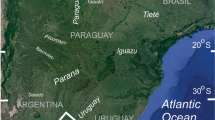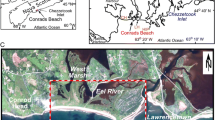Abstract
The chenier mechanism of the Subarnarekha deltaplain is dominated by the relative stillstand, transgression, and regression phases of marine environments in the Bay of Bengal region. The river carries sediment outlets into the shallow sea region of the Subarnarekha estuary mouth, which is further redistributed along the shoreline by the different reworking agents like waves, tides, currents, longshore drifts, and storm surges. Depending on the shoreline configurations and relative sea level positions during the stillstand, transgression, and regression phases, the voluminous sediments have been deposited around the respective shoreline positions as windblown sand sheets followed by beach ridge deposits by energetic wave actions. The inconsistency in shape, size, and orientation of the palaeo and recent sand dunes indicates the nature and strength of the sediment outlet by the Subarnarekha estuary associated with the strengthening monsoon phases, the dominance of southwestern and northeastern monsoons, and relative sea level positions in the deltaic region. The topographic expressions and width of inter-dune swales illustrate the relative strength of regression phases in the different periods. The present study has been carried out along the ~90 km coastline on both sides of the Subarnarekha delta region, from the Rasulpur river in the east to the Budhabalanga river in the west. The nine stages of dune ridges have been identified and demarcated using satellite imagery and field observations. The highly elevated and widely extended Contai-Paniparul dune ridge is situated at the extreme landward extent of the beach ridge–chenier system on the left side of the delta, while the Baliapal dune ridge is situated analogous to it on the right side of the delta. Such an extent is identical with the steady stillstand phase around 7000 years before present. The narrow and small extent of the Talsari dune ridge in the recent shoreline position demonstrates the negligible period of the stillstand phase (around 50 years), but shows dynamic shoreline characteristics during the monsoon months followed by the recent trend in sea level rise.
Access this chapter
Tax calculation will be finalised at checkout
Purchases are for personal use only
Similar content being viewed by others
References
Allison, M. A., Khan, S. R., Goodbred, S. L., Jr., & Kuehl, S. A. (2003). Stratigraphic evolution of the late Holocene Ganges–Brahmaputra lower delta plain. Sedimentary Geology, 155(3–4), 317–342.
Banerji, U. S., Arulbalaji, P., & Padmalal, D. (2020). Holocene climate variability and Indian summer monsoon: An overview. The Holocene. https://doi.org/10.1177/0959683619895577
Barman, N. K., Chatterjee, S., & Paul, A. K. (2016). Coastal morphodynamics: Integrated spatial modeling on the deltaic Balasore coast, India. Springer.
Biswas, A. (1987). Laterites and lateritoids of Bengal. In V. S. Datye, J. Diddee, S. R. Jog, & C. Patil (Eds.), Exploration in the tropics (pp. 157–167). Prof. K.R. Dikshit Felicitation Committee.
Biswas, S. K. (1993). Major neotectonic events during the Quaternary in Krishna-Godavari basin. Current Science India, 64(11–12), 797–803.
Ghosh, S., & Guchhait, S. (2015). Characterization and evolution of primary and secondary laterites in northwestern Bengal Basin, West Bengal, India. Journal of Palaeogeography, 4(2), 96–123.
Jana, S. (2017). Assessment of hydro-geomorphological aspects of middle and lower courses of Subarnarekha River and its Deltaic Part. Unpublished PhD thesis submitted to Vidyasagar University.
Jana, S. (2021). An automated approach in estimation and prediction of riverbank shifting for flood-prone middle-lower course of the Subarnarekha River, India. International Journal of River Basin Management, 19(3), 359–377. https://doi.org/10.1080/15715124.2019.1695259
Jana, S., & Paul, A. K. (2018). Genetical classification of deltaic and non-deltaic sequences of landforms of Subarnarekha middle course and lower course sections in Odisha and parts of West Bengal with application of geospatial technology. Journal of Coastal Science, 5(1), 16–26.
Jana, S., & Paul, A. K. (2019). Assessment of morphogenetic sedimentary depositional environments of different morphological surfaces of middle-lower and deltaic courses of Subarnarekha River. Journal of Coastal Science, 6(1), 1–11.
Jana, S., & Paul, A. K. (2020). Chronological evolution of the channel functional units in association with palaeo-hydrogeomorphological environment in the ancient delta fan of Subarnarekha basin, India. Environmental Earth Sciences, 9, 331. https://doi.org/10.1007/s12665-020-09093-1
Jana, S., & Paul, A. K. (2022). Plan shape geomorphology of Alluvial Valley in the middle-lower and deltaic courses of the Subarnarekha River basin, India. In Shit et al. (Eds.), Drainage basin dynamics (pp. 63–87). Springer Nature. https://doi.org/10.1007/978-3-030-79634-1_3
Jana, S., Paul, A. K., & Islam, S. M. (2014). Morphodynamics of barrier spits and tidal inlets of Subarnarekha Delta: A study at Talsari-Subarnapur spit, Odisha, India. Indian Journal of Geography and Environment, 13, 23–32.
Kaliraj, S., Chandrasekar, N., & Magesh, N. S. (2014). Impacts of wave energy and littoral currents on shoreline erosion/accretion along the south-west coast of Kanyakumari, Tamil Nadu using DSAS and geospatial technology. Environment and Earth Science, 71(10), 4523–4542.
Kamila, A., Paul, A. K., & Bandyopadhyay, J. (2021). Exploration of chronological development of coastal landscape: A review on geological and geomorphological history of Subarnarekha chenier delta region, West Bengal, India. Regional Studies in Marine Science, 1(44), 101726.
Kunte, P. D., & Wagle, B. G. (2005). The beach ridges of India: A review. Journal of Coastal Research, 1, 174–183.
Maiti, S. (2013). Interpretation of coastal morphodynamics of Subarnarekha estuary using integrated cartographic and field techniques. Current Science India, 104(12), 1709–1714.
Mallick, S., Bhattacharya, A., & Niyogi, D. (1972). A comparative study of the Quaternary formations in the Baitarani valley, Orissa with those of the Damodar-Ajoy delta area, Lower Ganga Basin. In Proceeding of seminar ‘Geomorphology, geohydrology and geotectonic of the Lower Ganga Basin’ (A91–A104).
Mandal, U., Sena, D. R., Dhar, A., Panda, S. N., Adhikary, P. P., & Mishra, P. K. (2021). Assessment of climate change and its impact on hydrological regimes and biomass yield of a tropical river basin. Ecological Indicators, 126, 107646. https://doi.org/10.1016/j.ecolind.2021.107646
Mokarrama, M., & Hojati, M. (2018). Landform classification using a subpixel spatial attraction model to increase spatial resolution of digital elevation model (DEM). Egyptian Journal of Remote Sensing and Space Science, 21(1), 111–120.
Niyogi, D. (1968). Morphology and evolution of the Subarnarekha Delta, India. Tridsskrift Saertrky af Geografisk, 67, 230–241.
Patel, A., Katiyar, S. K., & Prasad, V. (2016). Performances evaluation of different open source DEM using Differential Global Positioning System (DGPS). Egyptian Journal of Remote Sensing and Space Science, 19(1), 7–16.
Paul, A. K. (1996a). Chenier beach ridge and chenier sand ridge formations around Subarnarekha estuary. National Geographer, XX**(1&2), 143–153.
Paul, A. K. (1996b). Identification of coastal hazards in West Bengal and parts of Orissa. Indian Journal of Geomorphology, I(1) New Delhi, Academy & Law serials, 1–27.
Paul, A. K. (1997). Coastal erosion in West Bengal. MAEER, MIT Pune Journal, IV(15k &16k) (special issue on coastal environmental management), 66–84.
Paul, A. K. (2002). Coastal geomorphology and environment (pp. 1–342). ACB Publication.
Pavlis, N. K., Holmes, S. A., Kenyon, S. C., et al. (2012). The development and evaluation of the Earth Gravitational Model 2008 (EGM2008). Journal of Geophysical Research: Solid Earth, 117, B044406. https://doi.org/10.1029/2011JB008916
Sebastian, M., Behera, M. R., & Murty, P. L. N. (2019). Storm surge hydrodynamics at a concave coast due tovarying approach angles of cyclone. Ocean Engineering, 191. 106437 https://doi.org/10.1016/j.oceaneng.2019.106437
Author information
Authors and Affiliations
Corresponding author
Editor information
Editors and Affiliations
Rights and permissions
Copyright information
© 2023 The Author(s), under exclusive license to Springer Nature Switzerland AG
About this chapter
Cite this chapter
Jana, S. (2023). Shoreline Change and Associated Beach Ridge Chenier Formations in the Subarnarekha Delta Region, India. In: Paul, A.K., Paul, A. (eds) Crisis on the Coast and Hinterland. Springer, Cham. https://doi.org/10.1007/978-3-031-42231-7_3
Download citation
DOI: https://doi.org/10.1007/978-3-031-42231-7_3
Published:
Publisher Name: Springer, Cham
Print ISBN: 978-3-031-42230-0
Online ISBN: 978-3-031-42231-7
eBook Packages: Earth and Environmental ScienceEarth and Environmental Science (R0)




